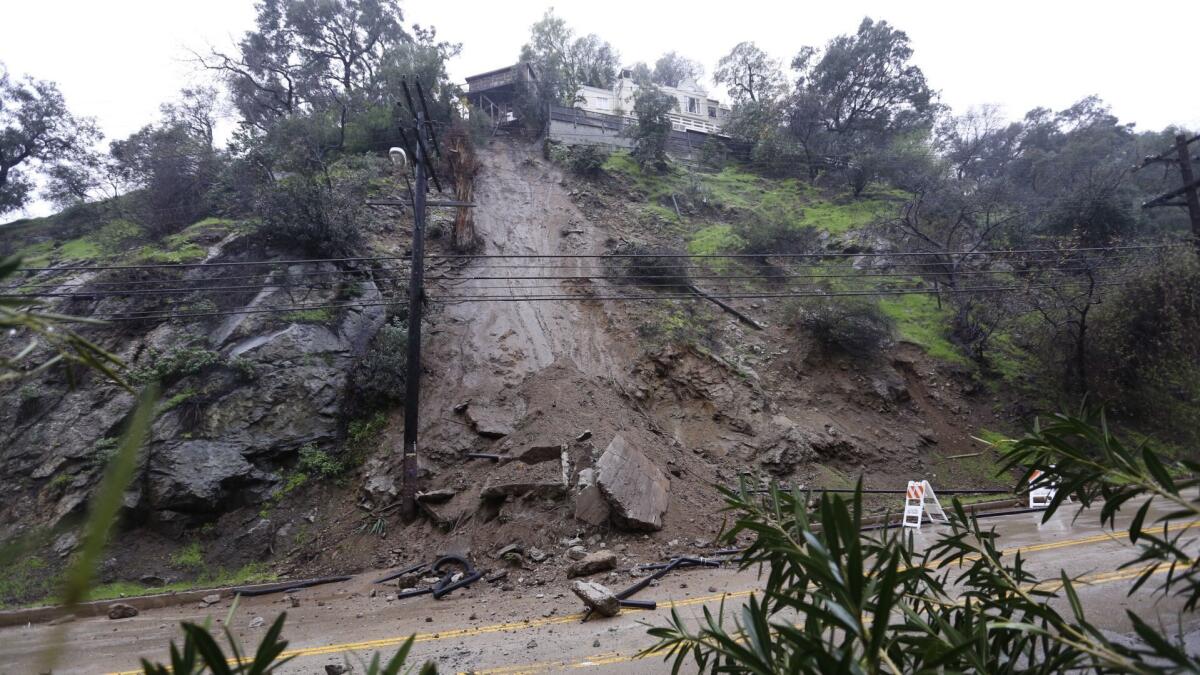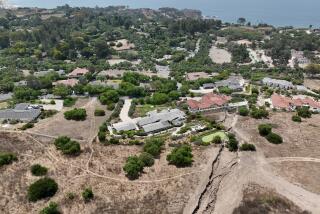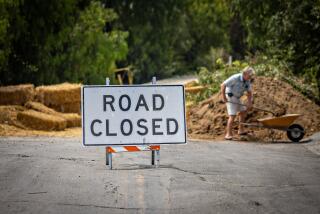Spotting the slippery slope: What to watch out for when buying a hillside home

This winter’s heavy rains were a blessing for California, relieving the prolonged drought, sending waterfalls cascading down mountainsides and giving rise to a spectacular super-bloom.
But for owners and potential buyers of hillside homes? Not so much.
Los Angeles has received more than 18 inches of rain this year, nearly 8 inches more than average. Water seeping into the soil has led to mudslides, landslides and slope instability, threatening many of the picturesque houses that loom over the city.
“Rain is the biggest cause of problems for hillside homes,” said Dave Grover of Grover Geology, who has examined at-risk properties since 1972. “Wet and dry cycles lead to heaving, shrinking of the soil and related building movement.”
The Hollywood Hills saw two landslides in January, including one that rendered Brett and Adria Copeland’s home uninhabitable.
The couple were renting on Gould Avenue in Laurel Canyon when Adria noticed a crack in the bottom deck. Heeding a gut feeling and the advice of friend in the contracting business, the couple decamped to a nearby hotel.
As they drove home the next morning, the Copelands were shocked by the sight of their balcony dangling off the cliff and the presence of city officials, who gave them 15 minutes to collect anything of value before the home was declared off-limits. Weeks later, the property is still red-tagged, with many of the Copelands’ belongings still inside.
Of course, homes in the hills will always be coveted, rain or not. But how to spot red flags if you’re looking to buy one?
Often, problems mount insidiously, inch by unseen inch. But uneven floors, misaligned doors and wall cracks are strong signals that buyers should take a second look.
“Homes that have a steep canyon behind them, or slopes that have been in a fire — that’s asking for trouble,” Grover said.
Jeff Napier of the Department of Building and Safety said signs of erosion from adjacent slopes, crumbling home foundations and cracks in the walkways can also be good hints.
Older homes are especially prone to issues.
“Back in the ’50s and ’60s, homes didn’t have the strict codes we have today,” Grover said. “You didn’t need to have elaborate geologic studies to make sure you were building retaining walls or debris collection devices that would protect the house.”
Real estate agent James Colin Campbell of Coldwell Banker always recommends that potential home buyers pay for the services of a geologist for hillside homes before they make an offer. Typical fees for a geologic report range from $1,000 to $1,700 for a 2,000- to 4,500-square-foot home; laboratory testing and engineering analyses would cost thousands more.
“It gives you a big hint if something is wrong,” Campbell said. “A geologist will research the property, check the site’s history and do a visual site inspection. A proper inspection protects the buyer.”
Buyers can also contact the L.A. Department of Building and Safety to request public records on a home’s past problems.
Although Grover relies on careful measurements during his home inspections, there are times when he has relied on a gut feeling. Once, he rejected a home that was seemingly perfect.
“It was a beautiful house, and the owners took care of it. You wouldn’t have been able to tell anything was wrong,” he said. “But the upslope behind it looked precarious to me.”
The following winter, the hill behind the property slid down, ruining the home. “The client wrote me a nice letter in appreciation,” he said.
The good news is that most of the time, issues with hillside homes can be addressed.
“Usually we find homes need drainage and minor hillside work,” Grover said, noting that that kind of minor corrective work costs about $5,000 to $15,000.
“If you get into foundation repairs [or] slope stabilization work, though, that can cost many tens of thousands of dollars, but that’s not as common,” he continued. “Most of the time, it’s small problems that can be solved.”
That’s welcome news for die-hard hillside residents such as the Copelands, who are now renting another Laurel Canyon home.
“You really just have to experience the community,” said Brett, a musician with the rock band Fire. “It’s all about the view, the trees and the wildlife. It’s like a different universe.”
MORE FROM HOT PROPERTY
Mount Washington Modern redo is open for entertaining
Actress Jane Fonda ponies up $5.45 million in cash for Century City town house
Beverly Hills estate once home to silent film star Corinne Griffith fetches $10.35 million
More to Read
Sign up for Essential California
The most important California stories and recommendations in your inbox every morning.
You may occasionally receive promotional content from the Los Angeles Times.






